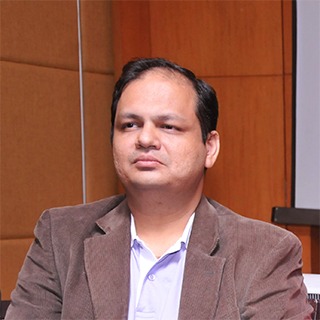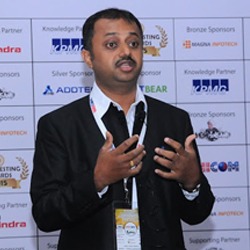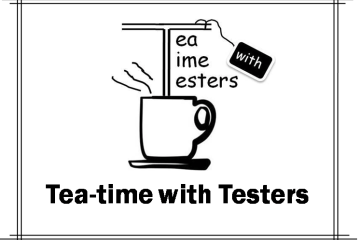2016 Conference Speakers
Global Testing Retreat Introduction and kick starting the event

Sundar is a banking and financial information technology professional leads large global teams. Sundar specialises in software quality and is focused on enhancing customer experience. Sundar joined Barclays Technology Center, India in its inception and was instrumental in setting up its testing practice from 2007. Under his stewardship, Sundar has matured a world class testing CoE which delivers quality with agility and innovation. Currently he heads the cards testing globally.
Sundar Ganesh
Keynote
Conway’s law states that every system is as great as the organization that created it. We want our systems to have quality on all levels. We want them to be functional, performant, usable and useful. And we want them to be successful. How do we create organizations which reliably create awesome software, delighting customers? Olaf offers an integral view at software and systems quality. Learn how the level of consciousness your organization operates from determines your effectiveness and quality. Take away how to start shifting that level next Monday.

Olaf Lewitz is a recovering agile coach and Trust Artist. He helps individuals and organisations shift their level of consciousness. He invites us to trust ourselves and others. He believes: You deserve to love what you do.
Olaf Lewitz
BDD: the Who, What, Where, When, Why and How.
In this session, we will take a different look at BDD. We will examine it from a birds-eye perspective. We won’t be looking at BDD merely as a testing technique, but as a holistic methodology for delivering business value to stakeholders.BDD was born out of a frustration with TDD. Old methods weren’t delivering the results that Business expected, so TDD had to evolve to include the Business in the conversation. This workshop will begin by looking at the Who, What, When, Where and Why of BDD. We will talk about how BDD is for the entire team; it is a means of collaboration, not for testing! The second part of the workshop will be a live coding session where we will see the How of BDD! This will be where we explore Outside In development. We will use Cucumber and Groovy to write a small application using the principals above. By the end of this session, you should have a deeper understanding of BDD, as well as providing you with a practical means of achieving your goals in collaboration with the rest of your team.

Marco Vermeulen is a South African Software Developer who works and lives in London. He is passionate about writing well crafted code, driven and guided by tests. As proponent of BDD, he has successfully applied this technique in the Enterprise as well as on Open Source Projects. When he gets a spare moment, he contributes to OSS and is the creator of SDKMAN (the Software Development Kit Manager).
Marco Vermeulen
Session on Cool JVM Tools to Help you Test.
Description: Sometimes we do not want to talk process, we do not like to business, we just want to talk tech – juicy, geeky tech. This is what we are going to do in this session – talk tech. The great thing about the JVM is that it is cross-platform and therefore useable on the platforms that most of us delivery products upon. Even if your core development platform is not the JVM, you still avail yourself to some of these tools to make your testing life easier. We are going to have whirl-wind tour through unit-testing, integration-testing, functional-testing, web-testing and API-testing. We are also going to look automating and deploying build infrastructure, making your life easier, so that you can have more time to spend on the most important part of testing – thinking. This session if also a pre-cursor to the post-conference workshop that I’ll be presenting. Which tools am I going to demonstrate? Come to the session and find out!

Schalk Cronje experience in the software industry spans three decades and has spoken and taught on various software delivery techniques in the UK, USA, India and South Africa. He has been an early adopter of test-driven design and development at all levels of testings and has applied TDD in many programming languages and on various platforms. One specific library he can recall is still in daily usage and is used in scanning millions of emails world-wide, yet the customer defect rate is less than one per year, all which can be attributed to TDD.
Schalk Cronje
Featured Session: Testing Women Leadership Café
Testing discipline has attracted women in larger percentage than any other profession. Women have excelled in this profession. While there are 50% or more women fresh engineers in testing at the entry level, the percentages dwindle as we consider higher levels in the career ladder. This is not a usual diversity talk on how women should manage their work-life. This session is about technical leadership stories of women who have progressed in their testing careers. Lets hear the inspirational career success stories in a relaxed café conversation hosted by Renu.

Renu Rajani is Vice President with Capgemini Testing Global Service Line (GSL) and leads Rightshore Sales Transformation Office and Sales Support. Renu has overall 25 years of experience in leading IT Services Delivery, IT Outsourcing Governance, Infrastructure Services, and Business/IT Consulting including Solution and Technical Sales. Prior to Capgemini, Renu served Citigroup, IBM, Satyam, and KPMG Consulting. Renu is Capgemini Global Testing thought leader featured on capgemini.com on “Managed Services”. Renu was recently conferred “Testing Leader of the Year 2015”. She is author of the book on Software Testing, published with McGrawHill. Renu holds an MS (Mgmt) from Purdue University USA, MBA (Finance), and B Tech degree in Computer Science. She is an IBM Sr PM Certified with DPE/SM discipline.
Renu Rajani
DevOps - Decoding the Da Vinci Code
DevOps is not a product, or even a particular technology. DevOps is a methodology that unites the often separate functions of softwaredevelopment (Dev) and production and operations (Ops) into a single, integrated, and continuous process. DevOps is about breaking down the barriers between Dev and Ops. It leverages people, processes, and technology to stimulate collaboration and innovation across the entire software development and release process. Dev and Ops must act and feel like they are a single team. But DevOps is never finished. Like a symphony orchestra learning a new score, or a sports team that has reached the playoffs,Dev and Ops have to keep pushing, collaborating in the pursuit of perfection. Since DevOps is never finished the paper concludes that it is a Fact or key factor of Software Value Chain

Dr. Shankar is a TQM (Total Quality Management) professional, who has spent much of his 23-years career managing change and improving software Quality Engineering efficiency through Data and Metrics driven Quality Management Systems. He believes in evangelizing, coaching and mentoring test teams through inspirational leadership. Shankar has a vast experience in setting up Test COE (Centre of Excellence) and has successfully carried out 6 rollouts on TPI/TMMI/Test Maturity frameworks for several companies. He has handled the entire gamut of testing landscape right from Pre Sales, Sales, Delivery and instituted a process temper in his earlier assignments.
Dr. Shankar Ramamoorthy
Digital Assurance – Today & Tomorrow
In today’s competitive business environment, IT development is increasingly driven by the customer experience. There is quite a paradigm shift a few years ago when IT organizations have embraced the agile and DevOps software development framework to overcome the hindrances of more traditional, rigid ‘waterfall’. At present, the market has reached its tipping point with digital at its fulcrum, manifested in multifaceted technologies. This further dictates the needs for the continuous quality through continuous testing using extreme automation viz. 4D Automation – end to end Application layers, across life cycle, varied technologies & devices, different testing types/levels…

Milind, heads the testing delivery for Banking and financial Services in L&T Infotech. A test professional with extensive experience in leading large global teams in banking and financial services industry enabling customers to mature their test organization with focus on Improved Quality Assurance and value appreciation for dollar spent on testing through Test Service Horizontalization, Test Innovation and Innovative Pricing model
Milind Prabhu
Anti Patterns of BDD - What is going Wrong?
Behavior Driven development has been one of the most popular practice in Agile community. In the recent times it has grown beyond what its original creators have imagined it to be. Dan North and some of associates proposed BDD as a practice to bring business/domain expert community to what used to be Dev centric practice of TDD. They took help of DSL (domain specific languages) to allow requirements to be specified in business language of the application. They thought – this would address some of concerns of TDD and wanted to get to rid of loaded phrase “Test”. It worked fine as long as the practice was followed in its original spirit. Over a period of time several antipatterns emerged that took many benefits away. These anti patterns are threatening to reduce BDD to be a ceremony than a practice that helps Agile community in the true spirit of Agile Manifesto. In this talk – I will explore these anti patterns with a historical background and share some experience of we can overcome the challenges and make better use of BDD.

Shrini Kulkarni is a Senior Technical Leader with over 18 years of IT experience with specialization in Quality Engineering, Testing, Agile and DevOps. Knowledgeable in Agile software development models, continuous integration and delivery models. Evangelist to accelerate transition and adoption of Agile practices in testing organizations. Experienced in delivering complex engineering/testing projects in cross geographical context across wide range business domains such as Banking, Insurance, Retail, Cards, Payments, Sanctions and others.
Shrini Kulkarni
The New Gives and Takes in a Tester’s Role
In today’s dynamic software development world, software tester’s role is evolving fast – testers are moving into an empowering role enabling product team and stakeholders own quality. This is becoming inevitable in the continuous delivery mode we operate in and as testers, to get there we need to revisit our roles – to see what needs to be given away and what needs to be taken on. At this important time of role evolution let’s understand what those gives and takes are and what it takes for a tester to thrive in the industry.

As Sr. Director of Engagement, Rajini Padmanaban leads the engagement management for some of QA InfoTech’s largest and most strategic accounts. She has over fourteen years of professional experience, primarily in software quality assurance. Rajini advocates software quality through evangelistic activities including blogging on test trends, technologies and best practices. She is also an active speaker in conferences run by SQE, QAI STC, UNICOM, EuroStar and has spoken at several webinars. Her writings are featured in TechWell, Sticky Minds, Better Software Magazine. She has co-authored a book on crowdsourced testing, and was most recently nominated for the Testing Leader of the Year award, by UNICOM. She can be reached at rajini.padmanaban@qainfotech.com
Rajini Padmanaban
50+ ways to improve tester-programmer relationship
This talk brings into picture a very important person – the programmer & the programming team. Each one of us might have the experience of working with at least one tough programmer. Some programmers are very friendly and help us with finding bugs. Some of them are very strict with their deliverables and do not respond to any queries outside office hours. Some hardly talk to you unless you ask them a question. There are different types of programmers and bring in variety to our testing challenges. With a rich experience of working with tough programmers, I present this talk to help you. I am very thankful to the programmers, especially the tough ones, as they are the ones who have taught me the most important lessons I had to learn to improve in my testing career.

Ajay Balamurugadas, goes by the handle ‘ajay184f’ in the testing community and is always continuously re-inventing his testing methodology. His passions include conducting online and in-person workshops on exploratory testing, mobile testing and helping testers discover their potential. Ajay shares his testing activities and learning through his blog http://EnjoyTesting.blogspot.com and tweets under @ajay184f.
Ajay Balamurugadas
Patterns of a good Test Automation Framework, Locators Data
Building a Test Automation Framework is easy – there are so many resources / guides / blogs / etc. available to help you get started and help solve the issues you get along the journey. However, building a “good” Test Automation Framework is not very easy. There are a lot of principles and practices you need to use, in the right context, with a good set of skills required to make the Test Automation Framework maintainable, scalable and reusable. Design Patterns play a big role in helping achieve this goal of building a good and robust framework.
In this talk, we will talk about, and see examples of various types of patterns you can use for:
1. Build your Test Automation Framework
2. Test Data Management
3. Locators / IDs (for finding / interacting with elements in the browser / app)
Using these patterns you will be able to build a good framework, that will help keep your tests running fast, and reliably in your CI / CD setup!

Anand Bagmar is a hands-on and result-oriented software quality evangelist with seventeen years in the IT field. Passionate about shipping quality products, Anand specializes in building automated testing tools, infrastructure, and frameworks. He writes testing-related blogs and has built open-source tools related to software testing—WAAT (Web Analytics Automation Testing Framework), TaaS (for automating integration testing in disparate systems), and TTA (Test Trend Analyzer).
Anand Bagmar
CODERS TESTERS - WE NEED NEW TESTING TOOLS (BRAINSTORMING)
A tool is something that helps a tester to test better. Nevertheless, Brain is the ultimate testing tool that nurtures the testing activity to be done better. And even when a tester thinks about a testing tool, it just means that he / she has an idea which was generated in the brain and want to use a particular tool to execute a test idea that was generated in the brain. We have plenty of tools in the computer world, just like plenty of fishes in the ocean. Having said that, these testing tools at times do not help a tester because of the limitations a tool provides or rather the feature was not thought of while developing it because it did not suit the context. Well, the good news is; computer programmers and software testers can come together to solve these problems quickly. This talk is going to help the audience to experience and ignite their brain to think in a new way in the path of innovating in testing tools, micro-services, utilities, web browser plug-ins and more.

Santosh Tuppad is a passionate software tester & expert tester who comes from context-driven school of testing and has tremendous experience in web application testing and mobile apps testing through exploratory testing approach. Be it functional testing or security testing, he is a punter. His love for computers started when he was 12 and at 16 he was a hacker. He founded TestInsane to create an ecosystem for people who want to live their dreams in testing doing great work while bringing delightful experience for customers.
Santosh Tuppad
Testing as a Container : using docker containers to deliver testing at speed
We see two upcoming trends in the world of software delivery.
1.Docker is becoming a standard for managing infrastructure using containers.
2.Testing code and its infrastructure starts to grow at scale with more complexity, dependencies and technology diversity.
A container is an entire portable runtime environment: an application, plus all its dependencies, libraries and other binaries, and configuration files needed to run it, bundled into one package. By containerizing the application platform and its dependencies ,all differences in OS distributions and underlying infrastructure are abstracted away which makes it easy to share and execute anywhere.
At this talk we will learn how to leverage the container technology to solve the challenges of growing testing infrastructure and continuous delivery with key focus on below items.
• Basics of the containers technology and specifically it’s application on the test automation.
• How Docker can reduce the time of test execution, ease the setup of clean test environments and drastically reduce the differences between the development, acceptance and production environments leading to the higher quality of the released software.
• Examples to containerize entire testing stack together consisting of major automation tools (selenium, appium, phantomjs), performance tools (jmeter,gatling) with cucumber.
• Integrating and managing testing container with other application containers to achieve easily manageable continuous delivery pipeline.
• Best practices and patterns for docker success.

Irfan Ahmad is working as a QA Lead ,holds ownership for the testing releases and devops of all technology deliverables across organisation. Full stack programmer and open source fan obsessed with quality software.Currentlyi am focused on test automation, Continuous delivery and BDD/TDD practices. Loves writing blogs, humour and game apps on mobile/web.
Irfan Ahmad
QAF - Next GEN Intelligent Scriptless Automation Framework
Script Less and Intelligent Automation is a state of the art test automation framework code named as QAF. The session will be a hands on demo of the framework. It automates both cross browser web application on platform running on (Windows, MAC) and cross mobile applications for both Android and iOS. Its inherent ability to learn about test suite gives it an incredible advantage over other tools or frameworks available in the market. It helps assess critical scenarios and provide recommendations on the next regression execution. It supports and works as a backbone to existing scripts written in any language (.Net, Java, Ruby etc). QAF also understands behavioral language and has an ability to pick up features files and create base scripts for your tests. QAF API also has an ability to connect existing continuous environment tools and fit into daily agile needs in any project. Recommendation is that everyone who wants to learn a little bit of Selenium and Appium bring a laptop of their own – the code and information will be shared during this session.

Soumya Mukherjee has 10+ years experience in Software Test Automation using professional tools like QTP, QC, LoadRunner, Jmeter, NeoloadGreenHat and with Open Source Tools like Selenium RC & Webdriver with Java .Net Python Ruby, FitNess, JMeter, SoapUI, TestNG, ReportNG, JUnit, Cucumber & Capybara, Tosca & Perfecto. Trained People at Thomson Reuters, Wells Fargo, Barclays, Capgemini, Aricent, LntInfotech, Ness Technologies, Qatar Petroleum … name a few. Developed Scriptless Test Automation web based tool / platform. Author of best selling book at amazon on “Selenium Starter Pack For “Smart Manual Tester”: Automation Foundation for Non-Programmers”
Soumya Mukherjee
One page to test them all
Page Object Model
Page Object Model was again a natural fit for this framework. Most implementations of POM recommend different POMs for each platform. But we wanted to have a single Page Object Model for all the 3 platforms to ensure maximum code reuse and reduce overall time spent in adding new automation.
Single Page Object Model across platforms
This is complicated because we had native screens as well as webview screens and so it was not possible to use the same Page Object. To solve this, we introduced abstractions for the elements on the screen and encapsulated the respective native driver implementations.
This also allowed us to implement common automation tasks in one place for e.g waiting for new pages to load, so that this code is not repeated across multiple step definitions and platforms. This helped us move to thinking in higher domain level concepts than in terms of low level UI interactions.
In this talk, walkthrough will given on how we designed this framework, what were our problems, and how we solved each one of them. Instead of giving you the solution upfront, we will present the problem to you, and discuss how they can be solved. And this will help you better appreciate the common problems in designing an automation framework and how they can solved using OO principles.

Priti is working as Quality Consultant in ThoughtWorks since last 3 years. She has worked on complex web projects and cross platform mobile applications. She has developed a keen interest in automation and, she keeps on automating daily chores in her work. Apart from this, you will find her solving more designing problems in OOPs way in Java, Ruby. In her spare time, you can find her improving dance skills or reading a novel. She keeps an aim to learn something new every day!
Priti Biyani
Products Fail because we Pass
A lot of products Fail in the market. When defects are found in production a lot of questions are asked to test teams. A typical defense by test team is showing test case coverage in terms of Pass/Fail. My entire talk is about what teams do against what users do.. What questions we should ask as testers, what we as testers should expect. This talk requires couple of microphones among audience as it is a complete interactive session.

Ramit belongs to the group of respectable innovators in the area of processes consulting & exploratory testing. He is an active blogger and frequent speaker in technology conferences, he has ability to nurture and grow the breakthrough ideas and mentor new talents. Ramit’s core expertise lies in being Agile, Exploratory testing, Risk Management and Test Management. He has been an early adopter of Risk Based Testing
Ramit Manohar Kaul
Big Data - Hadoop and MapReduce - new age tools for aid to testing and QA
BigData with its slew of technologies and terms has been the most talked about area in last couple of years. This has evolved in Big Data Science, Analytics and now on the IoT and automation side. There is a need for testers and QA team to not only get used to this new age digital transformation area but at the same time embrace the technology to their own advantage. We have experimented and successfully used Big Data Technologies – Hadoop and MapReduce for a recent testing engagement. The actual application was implemented using classic technologies like CentOS and C++. Testing team implemented Hadoop and MapReduce to help in quick turnaround for the testing. We would like to showcase the entire case study on how the tools and technologies came in handy for a High Frequency Trading (HFT) application and had we not implemented the same what would we have missed. We would also share the entire CentOS/Hadoop/MapReduce VM with the participants. This would require the attendees to bring their own laptop with at least 4GB RAM (Available) so that they do some hands on exercises that we would like to share.

Aditya has over 19 years of IT experience and he has been a test architect and principal consultant excelling in designing, strategizing and architecting manual and automation testing solutions. His primary focus has been in the area of establishing and leading testing center of excellence and practices, managing large IT projects, undertaking testing process studies using Six Sigma, CMMi and TMM models, proposing QA solutions, performance engineering and architecture reviews, designing automation frameworks, exploring open source test automation tools/frameworks and Business development.
Aditya Garg
Data driven testing using Appium, Cucumber and FitNesse
My topic will have demonstration of running Mobile test automation using FitNesse and Cucumber tools. Agility will be driven using test-first approach such as BDD and ATDD with data driven testing.

Ashish has over 20 years of experience in software testing, development, corporate training and public domain training. Over the period he has worked on number of projects as Account Manager, Test Manager, Programmer and Tester. His core expertise lies in Manual Testing, Test Automation and Test Management. He has been an early adopter of Selenium and has been able not only provide successful implementations using Selenium but also help in its propagation.
Ashish Mishra
GUIDABLE INCLUSIONS - The crux of Mobile Apps Testing
A mobile app for every small aspect in our life is the in thing today. Be it talking to your family millions of miles away or simply clicking a picture and letting the whole world know in a matter of few seconds “how good a photographer you are!”, there is an app for everything.Business rely on these apps to build brand value, to spread their wings farther and most importantly, to make their customer’s life easy. While, these apps are a great way for the customers to interact with the businesses, it is extremely annoying to the customers when these apps do not function the way they are supposed to. Testing these apps becomes extremely important before of in most cases even after the customer has started using the app. GUIDABLE INCLUSIONS is not just a mnemonic but a framework which lets you explore your app in the best possible way giving you results which you would have normally missed. It helps you look beyond the UI aspect or as they say the “look and feel” of the app and notice how your apps react in response to the way you interact with them or vice versa.
This session dives deeper into the following,
G – Gestures
U – User Scenarios and Usability
I – Integration
D- Devices and Platforms
B- Browsers
L – Location
E- Efficiency
I – Interrupts
N – Notifications
C- Compliance
L- Localization
U –Updates
S – Synchronization
I – Interaction
O- Orientation
N – Network
S- Security

Shivram Mani has been an principal consultant and test architect excelling in Automation Strategy and Project management (Manual and Automation). Shivram has done many trainings at corporate level, testing workshops, organized DoJo events and is passionate about technology. Shivram has excellent experience in Delivery Ownership, Stakeholder reporting, Metrics reporting, Daily Plan, Effort Estimation, Test Plan and Risk & Scope, Metrics, Process Improvement, Operations – UAT-QA Collaboration model, Knowledge Management, People Management, Vendor Management. Shivram has worked on following domains – Investment Banking – Structured Products and Options, Order Management (OMS), Trade Reporting Cycle, Payment Types – SWIFT, Electronic Trading Technologies
Shivram Mani

Brijesh Deb has more than 15 years of experience in the software testing. He has been responsible for establishing Test Engineering Practice rather than a Testing Practice. Brijesh has worked on multiple roles from a tester to a test engineer. Being mobile savvy helped him follow his heart in doing mobile testing. Apart from mobility, he has experience working on various domains like SEO, CRM, Storage, Education and more. Being an Agilist at heart, Brijesh has been responsible for establishing Agile Testing practices in the companies he has worked for.
Brijesh Deb
Using Docker for Testing
The early release of Docker (while it was in beta) was primarily used for testing. It was immediately accepted as the best tool which facilitated automation testing. Docker and its ecosystem have matured today to also support Docker in production. Tests typically include a number of different components like DB Server, App Server, Web server. Tests also depend on external services like MySQL, Redis. Moreover, the engineers are not very conversant with the testing infrastructure: A QA engineer should ideally focus on writing and executing tests. Failed tests pollute the test environment and resetting it back to a clean test environment is an overhead. Using Docker can address all these issues. This session aims to show how Docker can be effectively used in manual and automation testing. It will demonstrate how Docker can be used in CI + automation testing, which can form the base for your “continuous testing” approach.

Mukta has served the software industry as a technology geek, developer and devops enthusiast. She has varied experience across multiple technology stacks. She combines creativity with technology to contribute to the fast paced world of innovation! She loves to travel, read, write and is a mother to two boys.
Mukta Aphale
Continuous performance testing and test automation made easy with Taurus, Jenkins and Jmeter
When it comes to performance testing, JMeter is awesome but may not be complete. In this session, we’ll take a look at Taurus which is a free and open source automation framework, which is basically an abstraction layer over JMeter (or Grinder or Gatling or Selenium, with more tool support upcoming). The taurus tests can be easily integrated with jenkins using the available plugins and helps us in running the tests seamlessly.
Making Test Automation Simple with Taurus and Jmeter and integration with jenkins:
• Extremely simple setup and upgrading
• Ability to execute existing JMeter (or Grinder or Gatling or Selenium) tests
• The ability to create new tests from scratch using user-defined files
• Real-time reporting
• Ability to integrate with Jenkins for Continuous integration of performance tests
• Multiple test output formats
• Native results format of the underlying testing tool
• Console stats and pseudo-graphic charts during the test execution
• Easy way to define flexible pass/fail criteria. In case the results exceed a threshold, it is possible to automatically mark test(s) as failed
• platform-independent- runs where Python and Java can run

…
Dipanjan Haldar
Mind waves in testing
So my the topic goes with ” Mind Control Testing ” in which their will be a detailed presentation and a demo of 1. What is mind waves? 2. How to read the mind waves and use it to test a quality of application? 3. How it can be used in end user acceptance testing ? 4. How mind waves can be used to improve the quality software and production at the end user level And finally a small demo of my software which will read the brain waves and plot a graph and with a result saying 1. How attentive the user is 2. How cool the user is 3. How many times the user is blinking the eyes While using the application And a lot more fun & interesting things will be added on during the presentation…!

Working in L&T infotech as a test Engineer. Have got a best innovative project award form tcs insight camp during the year 2010 – 2011. Have participated in various national level science talks. I love to innovate things which people say “You cannot Do”.
Karthikeyan B
Service Virtualization – An arm that comes “Handy”
As the software industry moves from the Monolithic to absolutely componentized Service oriented architecture paradigm, it is not generally uncommon to have integrations almost always and dependencies quite often between several services. With the world being open to using third party already built up services it is a common scenario where world class products integrate with vendor provided services. All these lead to a problem of having interdependencies on these vendors or service providers that may be internal cross geographic teams or external vendors.

Dynamic and accomplished Technology Strategist with almost 13 years of experience in IT Software and Services industry including around 2.5 years of Cloud Computing and SaaS experience.
Kalpna Gulati
Test Data Management
In a financial business world dominated by DATA intensive applications there is constant need to collect, manipulate, store and retrieve of large amounts of data. In addition most of the applications being process oriented require analysis and implementation of complex business rules to the data.
Few examples are taxation, customs, excise application, mutual funds, Fund Management organizations, where the underlying data typically scales over time.
Given that the tolerance for faults and errors in such applications is very small, focus has to be bought on how to effectively use data for robust functional testing.
Mostly the data challenges are possible to manage from a manual testing perspective, but that becomes very cumbersome and inefficient overtime, especially for regression testing.
In order to automate the regression of such applications, usually there are 2 options:
1. Automation tool and scripts build in the complex business rules and validation points in-line with the application. This implies that when tests are executed with multiple data sets, the values calculated by scripts should match the ones generated by the application.
2. The other approach is to use Managed Data to test the functionality of the application. This approach proves more beneficial for data intensive applications where input data is changing frequently. It allows the functionality to be tested against a predictable outcome and insulates the application from external and internal dependencies.
3. The focus of our discussion will be ‘Testing with Managed Data’ – framework details, prerequisites, pros and cons compared to other approaches.

An accomplished Manager with 12 years experience in QA domain and over 2 years in Project Management.Extensive experience in Cloud based technologies with HP R&D labs in India. In-depth experience in Quality Assurance with focus on automation and core QA technologies.Certified Scrum Master with experience in implementing Agile and waterfall models for software development.Skilled leader with excellent communication and managerial skills, reflected in 99% score in employee survey.Proven ability to manage partner expectations both within India and with teams across geographies.
Charu Jain

16 years of experience in software development and support. Experienced in service industry as well as in house centers. Works as Sr Project Manager with Fidelity IBS Ltd. Extensive experience in development and support of applications relevant to Invesment Management business. Quite passionate in building softare for BFSI domain. Experience in managing diverse teams and external dependencies. Has worked in age old waterfall as well as new comers Agile aspects.
Sachin Goel
Demystifying DevOPS
• Business leaders know the value of adopting DevOps but Development and Operations team still struggling on how to adopt. There is gap in understanding how to transform Business Objectives to best practices & Technology Implementation.
• Development and Operations teams have very narrow view of DevOps – they still think just CI / CD Automation is DevOps. Automated & Integrated ALM as an approach remove silos in the organization is missing.
• Agile Coaches are trained and practicing primarily on software development side of things. Cross functional perspective ranging from Product Management to Portfolioto Release management is something they don’t have exposure on.
• DevOps is big change. Industry needs coaches / architects ( change agents ) who are capable and accountable to drive this change.
• DevOps is about operational efficiency at an enterprise level for Software Development centers; Lean / Kanban principles are the key but there seems to be Gap in industry on how to apply these to Software Development e.g. How to select an ALM, On what basis to select CI/CD tools

An astute professional with 12 years Experience who is Passionate about Customers, Products, Processes, Automation and People. Versatile individual who understands business and technology with deep software operations knowledge marching towards leading the DevOps transformations. Specialises at Product conceptualization, Building business case, Project planning, developing and maintaining a broad vision, cultivating excellent relationships, and communicating effectively across the organization to build focused and productive teams. Certified SAFe Program Consultant; Certified Product Manager ( AIPMM ) and completed International Post Graduate Certificate Program in Product Management & Marketing (ICPM) . Currently working as Product & Engineering Manager at Addteq Software ( DevOps and ALM ) Responsible for doing market research and coming up solutions to improve operations efficiency of software development companies. In the past played various roles PM, PL, Tech lead and Developer into product development and implementation across different industries ( Healthcare, Energy, Manufacturing ) across different domains ( PLM, ERP, ALM, Product Development )
Uday Kumar KV
Day 1 Test Engagement? Are you kidding me?
Purpose: To demonstrate how productivity can improve by engaging testers from the very first day of a sprint
Questions to ask yourself:
1. Does your team receive all the features at the end of the sprint for testing?
2. Do you have the concept of code freeze in your project?
3. Does your sprint usually spill over because testing is not completed?
4. Do you demonstrate features to your stakeholders that have not been tested?
5. and many more testing paradox…
If your answer to any of the above questions is YES, then it’s time to fix these problems.
In this session, not only will I demonstrate how you can engage your testing team from the very first day in order to start (that’s right, start) testing your application, but also help you achieve this by means of some simple exercises.

Agile Coach, Project Manager,Business Analyst, Software Engineer, and an Entrepreneur; based in India. I started off my IT career in 2008 and since then I’ve cursed myself about why I chose this profession. But at the end of everyday when I get back home and retrospect the brilliant day that I just spent at work, I get the answer to my question and don’t regret it. I have grown from a developer, to a business analyst, to a project manager, and God knows what is stored for me in the future. But I’m damn sure it’s good.
Vishal Prasad
CI/CV/CD = Baking Continuos Validation into the CI/CD process
A detailed walkthrough of how we have implemented automated+manual validations at every signifcant step of the CI/CD process. This results in built-in quality gate by using automation functional validation with tools like selenium, cucumber, jmeter, junit being used across the full infra stack from dev up to production environemnt. These validation processes act as toll gate for promotion of build from one stage to another as well.

Mohit is a SAFeAgilist, Certified ScrumMaster and Certified Product Owner, with over 14 years of experience in Agile Coaching (Scrum, Kanban), Delivery Management, Project Management, Solution Building/ Product & Application Development. He Holds distinction of managing a portfolio upto 5 M USD through the support of up to 90 member teams.Mohit’sDomain experience includes (US) Healthcare – Provider, Medical Devices, Pharma, Drug Discovery. Aptitude in effectively coordinating with Customers, Project Managers and Technical Teams of various horizontals within the organization for securing & executing concurrent projects.Diligent and self-motivated manager with expertise in driving product vision and product road mapping across various assignments; holds merit for managing multi-vendor projects.A customer-centric professional with a knack for motivating large workforces to exceed customer expectations through delivery of committed services.Capable of leading individuals/ technical teams to maximize levels of productivity.
Mohit Jain
Application Security - The Agile Way
Traditionally application security has involved upfront design and a big bang penetration test after development. This leads to the phenomenon of “bolt-on” security that translates into increased cost and complexity. Drawing on our experience on real-world projects we show how security can be baked-in on an agile project. Using case studies we demonstrate how security concerns are captured during project inceptions, how developers write secure code, security testing is automated and how configuration management can help achieve secure deployments. This talk introduces several new concepts like secure by design, secure design patterns and lightweight code reviews.

Shirish Padalkar is a Senior Consultant at ThoughtWorks. He works as a Java, Scala developer and Security Specialist. He has been working on secure development and security testing for the last 5 years. Shirish is passionate about finding security vulnerabilities in software. He has reported vulnerabilities in multiple well known websites and received acclamation for it. Shirish has published the book “97 things every programmer should know – Extended”. He frequently speaks on security at conferences in ThoughtWorks and is a moderator for Null, the open security community.
Shirish Padalkar
Quality Assurance in DevOps and SecOps World
I would like to give talk on How the Quality Assurance and Testing is different in DevOps and SecOps World.
Following is the flow of the talk:
• Continuous Delivery and Continuous Testing
• DevOps and SecOps
• Literature Review – A brief about some of the best practices
• System Thinking and How to build Quality and Security into the system
• Architecting for Continuous Delivery
• Build Pipeline and how to make it effective
• Static and Dynamic analysis and inputs to the testing
• Running Security in the Build Pipeline
• Bringing the Operations perspective up in the life cycle
• Continuous Deployment and Monitoring
• Upcoming /Happening Trends (Microservices, Containerization and others)
• Summary and Way forward

Anish Cheriyan is the Director of Quality in Huawei Technologies India Private Limited. He has led Agile Transformation Task Forces at organization level. He has worked with teams as Agile coach in the Telecom Network Management, Application Development and Core Network domain. Anish has worked with teams for continuous integration and delivery adoption and further deployment. He is a Research Scholar pursuing his Doctorate (PhD).
Anish Cheriyan
Wiki Based Automation Testing using Fitnesse - with relevance to DevOps
Description of the Tool
How to integrate Fitnesse with Selenium (Browser testing), J-Shell (Unix testing) and JDBC (DB testing)
Advantages of using Fitnesse
Exceptions handing scenario’s in Automation testing
How to use Fitnesse for DevOps
An Example where this was used for Banking application and how it benefitted the Client.
Best Practices for Automation testing
Tool selections ideas

Subrato Dashas 10 years of Experience in IT Industry. My interests are
1) Automation testing
2) Performance testing
3) Team Management
4) Java , Unix and SQL
5) Mobile Payments
6) Investment Banking – Trading , SWAPS and Collateral Management
Subrato Das
Augmenetd Reality and Software Testing: A Futuristic Thought Process
Augmented Reality is a breakthrough technology that could considerably ease execution of complex operations. Augmented Reality mixes virtual and actual reality, making available to the user new tools to ensure efficiency in the transfer of knowledge for several processes and in several environments. Various solutions based on Augmented Reality have been proposed by the research community: particularly in maintenance operations Augmented Reality tools have offered new perspectives and have promised dramatic improvements. On the other side Augmented Reality is an extremely demanding technology and, at the present day, it is still affected by serious flaws that undermine its implementations in the industrial context. This paper presents examples of Augmented Reality applications and shows the feasibility of Augmented Reality solutions, underlining advantages it could introduce. At the same time the principal flaws of Augmented Reality are commented and possible lines of investigation are suggested.

I have 2+ years of experience. Worked on automation of Web based and SAP based applications. Currently working on SAP SD testing.
Sourabh Dhavale
Brace yourself from an automation death trap
We all in the voyage to test effectively always think about test automation & let me tell you, its no less crucial & important than production app code. Its a code/framework/architecture built to test your app code and catch some of app defects. This when placed in an eco-system of continuous integration & deployment takes a next level of importance. I have been fortunate enough to have had my share of failures & eventually learn out of it while automating. In this session, I wish to take my audience through the importance of automation in Agile, the essentials to think of while deciding the tools and also take some tangible take-aways while writing automation code. The take-aways will be some technical inputs which have immensely helped me to build flexible frameworks for delivery of enterprise products. The aspects this take-aways will touch are on the pressings issues an automation tester face around test data management, code modularization, defining the clarity on responsibilities of different modules/classes written in an automation framework. This session will be a good dialogue & overall making us think to stay away from the obvious failures.

Prasad is a Software Quality Enthusiast with over 9 years of experience in IT out of which he has spent majorly with ThoughtWorks. He has helped in introducing and executing good testing practices for multiple clients at ThoughtWorks. His clientele have been under enterprise Travel &eCommerce(web & mobile apps) domains & also at times solely for a consulting gigs. He always brings an important perspective of how QA is crucial in Agile. He has also worked on different automation tools & frameworks on his journey of an QA. Cucumber, Selenium Webdriver, Calabash, Watir are some tools to name a few along with Java, Ruby & .Net technology stacks.
Prasad Kalgutkar
Mobile Native Apps Performance Testing using open source tool JMeter
Challenge:
Performance Testing of Mobile Apps in Low Cost.
Solution:
We have come up with a platform independent approach to generate the scripts for Mobile native applications using real device interactions with server. We capture traffic using a proxy server with JMeter installed and routing all the requests from real device to this proxy server. This approach is much closer to the real world traffic simulation as compared to that of emulators and produces accurate performance testing results.

Devendra has more than 4.5 years of experience in Automation and Performance Testing. He is working as a key resource in Testing CoE of Nihilent Technologies Private Limited and his role is to look for innovative solutions and implement that in projects to increase efficiency and reduce costs. Earlier in his career, he has worked with IT giants like Capgemini and Fiserv with same kind of role and got Bronze Star award and Value in Performance award for his innovative solutions. He is passionate about learning new tools and technologies coming in market and developed various accelerators to assist and reduce turnaround time in Performance testing and Automation testing. He holds various certifications like HP Loadrunner AIS Certification, Neotys Certified Professional and ISTQB Certified Tester. Devendra is also a blogger and actively participates in on line forums to learn and assist others.
Devendra Singh
Modelling QA Transformation With PRIME Framework
This is very interesting time for QA industry with QA definitions being re-written with Agile and DevOps trend. Expectations from QA changing significantly with business trends around Digital, Data Analytics and many more! Though, at one end we observe changes in perception around QA, in parallel QA also continues to keep riding maturity wave rapidly and especially where it had an early start to continue adopting to changes in software engineering. This upliftment of QA maturity is primarily coming in form of QA Transformation. QA Transformation is the mechanism where QA maturity upside move is being planned and executed leveraging different QA solutions, processes & capabilities focusing on evolving business objectives.

Sumit is Senior Manager at Capgemini, India with over 15 years’ experience in QA delivery, Transformation and driving COEs across Banking and Logistics domains. Currently, Sumit Kumar heads Technology Center of Excellences for Testing Practice in Capgemini. Sumit has managed large size QA delivery portfolios involving large size programs/projects for various global banks in right shore model. He has developed solutions collaborating with Clients’ offshore captive center and establishing different engagement models including MTS engagements. He has played various key roles at QA onshore and offshore organizations in recent years.
Sumit Kumar
Automation testing approach for Responsive Web Design website
In the market today, there are a large number of devices with different resolutions and screen sizes. A tough competition exists wherein every client wants their website to run on all these devices.
Testing the same set of test cases on all the available devices in the market today is practically impossible due to the high cost factor, availability of all devices and amount of effort required to test on all these devices. Nowadays, most of the websites are being developed as Responsive web design(RWD) websites. The RWD websites layout will adjust based on the screen size and PPI of the device. The main challenge for testing RWD websites is that the automation script generated for one device one platform will only cover the functionality, behavior and workflow. But the same automation script running on different devices ignores the look and feel, Layout and UI alignment.
This Paper talks about using multiple tools available in the market currently for testing RWD website and our experiences related to them. We have focused majorly on screenshot analysis and pixel by pixel comparison. We also have capability to execute parallel test cases for RWD website across multiple devices having multiple resolutions in one go along with continuous integration using Selenium and Jenkins.

Is Technology Analyst working with Infosys Digital with overall 5+ years. I have extensive experience in manual, white box, API, Unit, Automation and performance testing on web applications, mobile devices. I have been involved in creating test cases, test plan, test strategy, automation framework, automation script and performance script. I have worked upon many automation tools like Selenium web driver, Soasta, M-eux, Robotium and Monkey Talk. He is currently involved in automation testing activities. You can reach me at prateek_yadav@infosys.com
Prateek Yadav

Nirmal Jacob is a Technology Architect working with Infosys Digital having 9+ years of IT experience. He has been working on mobile application development projects over the last 5 years and prior to that in web development projects. He has special interest in automation technology used in mobile development and QA. You can reach him at nirmalpaul_jacob@infosys.com
Nirmal Jacob
Amalgamation of Behavior driven development (BDD), parallel execution and mobile automation
With the rise of Mobile first approaches, a substantial traffic has now shifted from the desktops to the Mobile phones. To ensure quality in mobile apps, Testing needs to be continuous and inclusive. This makes Mobile Test Automation a formidable business driver. Along with that there needs to be strong collaboration between developers, testers and non-technical or business participants in a software project to maintain application consistency across multiple platforms. The intent of our whitepaper will be to provide a comprehensive mobile automation testing strategy using Behaviour Driven Development, optimized selection of target devices, and an effective combination of manual and automated testing tools to cover appropriate functional testing essential for getting your mobile applications to market on time and within budget. This paper will also discuss on how the scenarios which are derived from the requirement can be automated using BDD approach across Web and Mobile. Also, it will highlight on how parallel execution can be achieved using BDD & Mobile Automation.

Mradul Kapoor is working in one of the leading consulting firm based in Mumbai, India. His experience, knowledge and skills include Business Analysis, Automation and Functional Testing. Mradul has worked on various testing tools like QTP, Selenium, Oracle Oats, Coded UI, SpecFlow, SpecLog, Appium, Microsoft team system and various test management tools. He has over 7.5 years of experience in US Healthcare, Insurance, eLearning, Life Science and Human and Health Services
Mradul Kapoor

Jigesh Shah is working in one of the leading consulting firm based in Mumbai, India. His experience, knowledge and skills include Business Automation and Functional Testing. Jigesh a Certified Java Programmer has worked on various testing tools like QTP, Selenium, QC, Rally, JIRA ,SpecFlow, SpecLog, Appium, Microsoft team system and various test management tools. He has over 7.5 years of experience in US Healthcare, Insurance, and eLearning.
Jignesh Shah
Testing the Mysterious Sphere
This workshop helps testers get an overview of what to do and what not to do under different circumstances. Then it is observed how they react/respond in those situations from where the learnings are derived. It focusses on the key testing and consulting skills. They can tie it back to real time project experiences. Through a series of interesting phases with role plays and activities the entire workshop duration is full of energy and interactions.

I have been in IT for more than 5 years now. In the course of my career I have worked on automating web applications with various frameworks using Java, Selenium, Ruby, cucumber. I have also done performance testing via JMeter and Gatling. Apart from finding bugs, in my spare time I like to read, watch movies and shop. I also enjoy travelling and exploring new places.
Anjali Wadhwa

I have been in the industry for three and a half years now. Having worked mainly on mobile apps, I have donned multiple hats from Quality Analyst to Developer. I have keen interest in the infrastructure,CI,CD and devops side of things.
Nikitha Iyer
Continuous Testing - How to transform traditional testing to support agile project delivery, its challenges and best practices
This topic will cover How to transform traditional testing to support agile project delivery, its challenges and best practices.
Open source Vs Not so Open Source Tools Set, the trade off and where should we stop?
Automation is a big space and so is the solutions around it. There are high expectations from the expert to provide the best possible economic, efficient, easy to implement, easy to maintain, easy to adopt, easy to migrate solutions, which should be low risk with high throughput. Can this be achieved? Yes! But is takes a lot to reach here. And what enables an organization to reach a stage when they can claim that automation is getting implemented fairly and is giving expected ROI? It is a team of expert having a vast knowledge about the tools and technologies that make it possible. The question is how one selects which tool set to choose and what works best for a specific organization. It varies from the type of organization to what actually is important for the organization. For instance some may have quick ROI as there focus area, some may have quick result as there focus area and some may want both. The paper will cover various approaches towards tools and technology selection for giving the best possible automation solution.

Somajit is a Principal Solution Architect at Tech Mahindra. He has over 17 years of experience and has rich experience in architecting and managing solutions that are deigned to make life easy.
Somajit Bhattacharya
Behavior Driven Development – with Analytics driven “Day-In-A-Life” approach (Stories from Microsoft, Reliance Jio& NICE
With systems getting larger and larger and more complex, it is becoming challenging to keep it with Testing the whole system and impacts user experience. Typically systems used to get designed & developed with “requirements and specifications”. But, we all know users use the system in a particular way and it may not be the same way it is designed. Large software systems like Outlook and Excel are used by millions of users worldwide – there are certain users use it in a way and others use it in different way. With Mobile apps it becomes even more critical. The key here to understand the behavior and plan the system accordingly. It is two way street – one, we need to come up with behavior patterns and create those stories and second need to have an in-built App monitoring in place to capture the “real” behavior. At Microsoft, we build a system to be able to do this called “Day-In-A-Life” and helped setup a story upfront and then measure and use it to optimize the user experience with inbuilt measures and analytics. In this presentation Mukesh Jain is going to share his experience implementing Behavior Driven Development – with Analytics driven “Day-In-A-Life” approach.

Mukesh Jain is Educationist, Author, Coach and Techno-Biz Leader with 20+ yrs of experience working with legendary people like Bill Gates, Satya Nadella and MukeshAmbani. He have built & led multiple globalteams and delivered analytics driven innovativeproducts that used by Millions of people worldwide. He is the Vice President(R&D)&Head of NICE Systems in Pune. He has setup NICE in Pune and is leading R&D in areas of Machine Learning&Big Data based large scale Analytics Platform in Financial and Experience domains that are used by 85% of Fortune 100 companies. In Pune, he attracted and hired 310 engineers in 9 months and expend to 600 highliy capable R&D teams by 2016.
Mukesh Jain
Test Automation in Agile
Our World Quality Report in 2009 indicated that less than 25% of organizations had implemented automation and the WQR 2015-16 indicates that the levels show a phenomenal increase to about 54%. The key drivers behind this are the need to speeden up the time to market being implemented by the adoption of Agile development and testing. The industry now, more widely than ever, acknowledges that better detection of defects is a direct benefit of automation. Our research in 2015 also indicates that reliance on manual testing has become the most important technical challenge for application development. How can we then link the benefits of automation and agile together? The biggest benefit is early detection of defects reducing the overall cost of quality. What does this mean to testing as a profession? Testers will have to undergo a paradigm mindset shift from manual testing in a waterfall model to more automated testing in a cloud or virtualized environment with weekly or fortnightly production deployments and stringent KPIs on reducing the cost of quality. In this topic, I will analyze the evolution of automation w.r.t. agile development and testing, some of the challenges that CxOs face w.r.t. investments in automation, best practices in agile automation and a sneak peek into the future of automation in the agile development world.

Vaishali Jayade is a Senior Manager in Capagemini in Testing Services. She brings with her about 19 years of experience in the IT industry having worked with organizations like Citicorp Overseas Software Ltd (COSL / Polaris) and Kale Consultants. She has been a part of Capgemini Testing Service Line since the past 9 years and has performed key roles in Europe and APAC BUs across delivery, sales and COE. Known to be a people oriented leader, she is an expert in testing solutioning and solution sales, conducting TPIs, and test strategizing and setting up COEs.
Vaishali Jayade
Getting High on Espresso
Imagine a situation where every commit spits out a build that can be deployed to production with confidence. In today’s startup era, this can be a huge boost to business as it will reduce the time to market. UI Automation for mobile apps has been painful since long. But with mature frameworks coming up and Google/Apple realizing the importance of such tools, UI Automation is gaining traction in the mobile space. This talk will focus on Espresso (UI Automation framework for Android from Google) and highlight it’s key benefits compared to other tools like Appium, Calabash, etc. Ketan will share experiences from the trenches of how Espresso solved many of the problems unique to his project at work. You will learn, how they overcame the challenges, and built trust for the team in knowing exactly what the state of quality of our app is, at all points in the development life cycle.

…
Ketan Soni
Mobile application testing best practices, Automation approach while working in Agile
Topic is to cover types of test automation tools for mobile applications – Market trends and best approach towards selecting right tool while working in Agile. I would like to give input over non-functional testing for mobile applications, do and don’ts, How to cover all the aspects in terms of mobile application testing. Topic will also cover tools demo with real world scenario.

Sumit is a Result-oriented professional with experience in mobility domain, mobile application quality assurance, automation testing, API testing for mobile applications and library. Experience includes BYOD, MDM testing, Performance and benchmark testing for mobile applications. Currently associated with the Vodafone Shared Services India.
Sumit Mundhada
QA to Dev'QA'Ops
With the concept of Infrastructure as Code gaining momentum, along with the concept of DevOps, it’s important to check the sanity of the Infrastructure as a whole. This talk aims to introduce some concepts of testing for DevOps and how QA can help in testing the infrastructure.

Yahya Poonawala is a Senior Software Engineer at Hem. His interests lie in designing solutions to problems, databases and more recently devops. He is also passionate about teaching and finds opportunities where he can spread the finite knowledge that he possesses. In his spare time, you can find him reading a novel, or writing about himself in the third person.
Yahya Poonawala

Application Developer at ThoughtWorks, working with Scala and Ruby Technology. Worked on infrastructure testing and automation using Chef on in-house data center and on AWS.
Siddharth Kulkarni
IOT: Testing : How the traditional testing needs to evolve to validate IoT
In this session, we will first introduce the audience to Internet of Things (IoT) and then go into details of IoT’s Connect, Collect and Consume framework. Gartner* is estimating 6.4 billion connected things in 2016 growing to 20.8 billion connected devices by 2020. The estimated spending is $235 billion for 2016. We will explain the IoT Landscape and its various. We will then discuss how the traditional testing needs to evolve to validate IoT and talk about unique challenges and opportunities. The intent is not to provide solutions for the challenges, but to initiate thought-provoking discussions and encourage innovation in this field.

Shardul Rao is an accomplished management executive with 18+ years of experience in delivering multi-million dollar software and hardware products. Influential and persuasive leader with a proven track record of developing strategic plans, managing multiple teams & projects, and driving continuous improvements. Ability to learn and manage new technology/domain and effectively work with customers to maintain their business and generate new opportunities.





























































